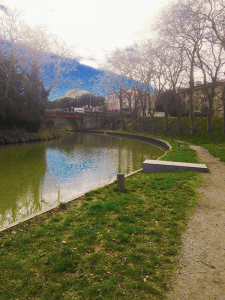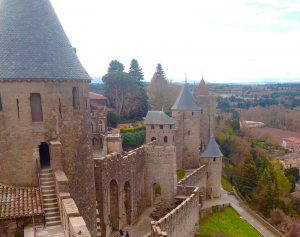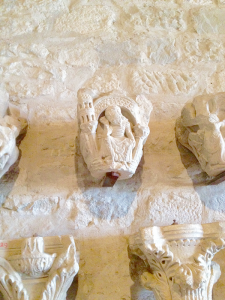Exploring Sleeping Beauty’s Castle in the South of France
By Michele Reed michele@cny55.com
Photos by Bill Reed

In the South of France, it’s possible to walk the high ramparts of Sleeping Beauty’s castle. Not the real one, but the inspiration for the Disney movie version. It’s the medieval walled city of Carcassonne — the third most visited city in France and a mecca for British vacationers who get cheap flights on Ryan Air and other UK carriers.
We were able to do a day trip. It was easy and affordable, since the train arrives in Carcassonne at 10 a.m. and the afternoon one leaves at 5 p.m., getting us home by 7 p.m. All for only $60.
When we arrived we were pleasantly surprised at how beautiful the city appeared. Surrounding the train station are art deco buildings, including an old railroad hotel.
As we made the 45-minute walk to the medieval part of the city, we had to stop and stare at beautiful architecture from the 19th and early 20th centuries. Even public bathrooms were interesting to see, freestanding round structures of metal topped with wrought iron tracery and elegant signs proclaiming Toilettes.
To get to the walled medieval city we crossed the Pont Vieux (the old bridge), which arches over the River Aude — a formidable barrier but hardly the evil fairy’s thorny branches. The bridge has stone balustrades and beautiful copper light fixtures suspended on wrought iron arches in the center of the roadway. Exactly halfway over, a stone cross stands, worn by the ages, but still a moving sight.
As we entered the bridge on the city side, built into its foundations was the tiny chapel of Notre Dame de Santé (Our Lady of Good Health). “Tiny” barely describes the size of it. Picture a small American bedroom, with an altar and church pews. The statue of Notre Dame stands upon the altar and another holy statue venerated by the people is on a side wall enclosed in a metal grate and glass covering. A special prayer is posted to ask the Holy Mother’s help, especially in times of ill health. Those who were blessed with restoration of health have placed marble blocks on the wall, most saying only “Merci” — thank you.
Approaching the medieval city is truly awe-inspiring. It rises out of the hill and you at first see a portion and think, “That’s pretty impressive.” Then a little more is visible and then more and then more, until you are in the shadow of a massive fortified city that has stood for centuries.
Visitors can enter via the Narbonne Gate and despite the flocks of school kids from several countries massed around it with their teachers, you can’t help but be impressed. You cross a drawbridge of massive proportions flanked by two towers. Surely any enemies approaching would have been warned that this city and its defenders meant business. Just inside the gates there is a dry moat with tiny plots where a man in costume tended ancient varieties of fruits and vegetables.

Upon paying our fee and going into the vast courtyard, we looked up at the ramparts. They were so high we declared, “No way we are climbing those!” We agreed that we would just follow the tour and turn around before it got too high. Oh, silly us. This is France. Once you enter a historic site, you have to follow the designated path until the end. There is no going back.
A modern visitors’ gallery traced the history of the chateau from its Roman-era beginnings through the Albigensian crusades in the 1200s, when the castle withstood a siege by the forces of Christianity massed against the Cathar heretics.
Then under King Louis IX the city fortifications were extended and improved. During the French Revolution of 1789-99, however, much was destroyed and the place fell into ruin.
In the 19th century, French architect Eugene Viollet-le-Duc, famous for his work on Mont Saint-Michel and Notre Dame Cathedral, undertook a massive project to plan restoration work on the chateau and city.
We started the tour and it led up and up via stone stairs worn by the passage of a thousand years of feet. Soon we found ourselves at the very top the medieval tower that we had marveled at from below. Twisty paths and narrow staircases led up and out onto the ramparts we had sworn not to walk. It was worth the effort and the views out across the Aude River and the surrounding countryside were magnificent. We could even see as far as the Pyrenees Mountains. (The Spanish were a major enemy that the castle defended against.) There was a tower with a window seat, and I gave myself the luxury of sitting on that and looking out the leaded glass windows to the mountains far away.
The ramparts were quite open; we could touch the stones where defenders would shoot their arrows or drop rocks upon invading forces. Viollet-le-Duc had added heavy boards with small arrow slits on the outer walls.
The tour ended in a simple museum of statuary and other art. Unlike in most American museums, you could actually touch the medieval statues and Roman antiquities. Little children played on ancient artifacts and no one stopped them.
The museum finished up with modern depictions of the castle. In addition to Disney books, displayed here in French translations, the walled city appeared in various models, toys and video games.

In the summer Carcassonne can be a kind of Disneyland, crowded and crazy with tourists. We visited on a cloudy and chilly day in March, but still we were surrounded by school groups and tourists from all over the world. We heard German, Spanish and Italian being spoken, as well as of course, French and English.
Shops and food kiosks abounded. Here you could buy toy crossbows and swords, there medieval armor costumes and princess hats. A few more upscale stores sold Provençal table cloths and local pottery.
We still had plenty of time to kill, so I got to fulfill a long-held dream to see the Canal du Midi. We walked along the towpath under the shade of the plane trees for a stretch and basked in unexpected sunshine on a park bench watching the ducks swim by, until it was time to catch the train home.
We were home by dinnertime, marveling at our fairy-tale adventure in the history-rich South of France.
Michele Reed retired after a career spanning four decades in public relations, advertising, journalism and higher education. She now writes travel articles, book reviews, haiku poetry and fiction. Bill Reed retired after four decades in social services with the county of Oswego, and now works at travel photography and photojournalism, along with writing book reviews.

